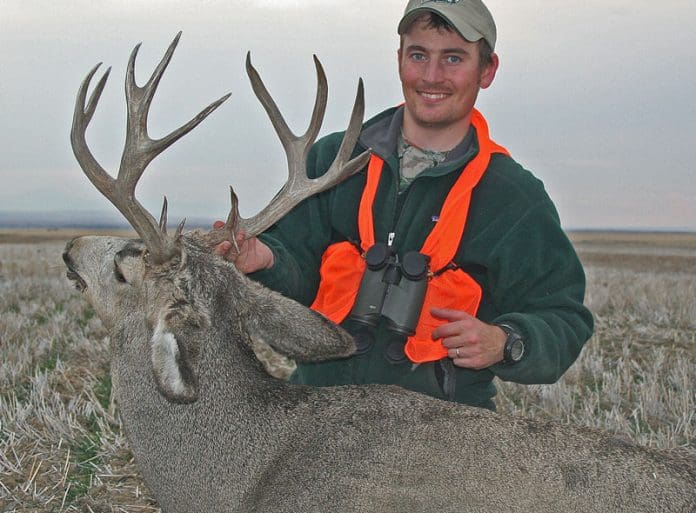Meopta S2 HD 82mm Spotting Scope
by Matt Cashell
The “Big Three” get all the glory when it comes to European Optics. Zeiss, Leica, and Swarovski earned this reputation through many years of offering optical instruments of the highest quality. They led the way in a lot of optical technology including multi-coating, phase-coating, etc… However, they aren’t the only optics producers in Europe. Besides Swarovski, Austria is also the home of sister company Kahles. In addition to Zeiss, Germany also houses Docter Optics (formerly Zeiss Jena) Steiner, and Minox. Then when we head a little further East, we arrive at the Czech Republic. Here Meopta has been precision manufacturing quality optics since 1933 (mostly darkroom equipment then). To put that in perspective Swarovski Optik was formed two years later in 1935.
Through the late 30’s and early 40’s Meopta produces volumes of military optics at the demand of the German Army. Afterwards the company focused on making the best cinema projectors in the world. Military optic production again comes to the forefront in the 70’s. In the late 80’s Meopta again turns the page to consumer sports optics.
Fast forward to 2004 and Meopta joins forces with New York optical company TCI, and Meopta optics start getting marketed in the USA. Finally in 2005 TCI became Meopta USA.
Since that time I have seen a number of Meopta sport optics, and all that experience doesn’t go to waste. Here we have that rumored “Euro” optical quality at often quite lower price points. In 2007, I acquired a 10X42 Meostar binocular, and used it extensively all over Montana. It was super tough, and even rolled down an avalanche chute turning out at the bottom no worse for wear. I really enjoyed that binocular, but eventually sold it after finding similar products with a little better Chromatic Aberration (CA) control and less of a warm, yellow color bias.
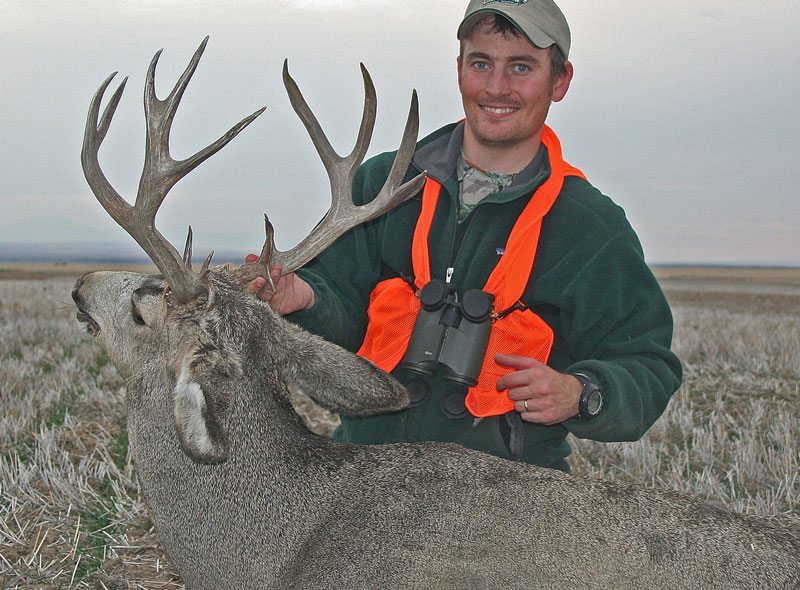
The author on a successful hunt with the older Meostar B1 10X42 binocular
I began hearing positive rumblings some time ago of an “HD” version of the Meostar binocular, and I wondered if the minor issues I had with the original had been addressed. Well, recently Meopta USA was kind enough to send me the 10X42 Meostar HD binocular, 30-60X82 S2 HD spotting scope, and 3-9X42 Meopro BDC riflescope for evaluation. Not only that, but I found two “Meopix” digiscoping adapters for the iPhone 4 for use with the binoculars and spotter. I spent weeks dragging them all over and peering through them over burnt ridges, snowy meadows, shadowy pine pockets, and other gorgeous Montana views.
Meopta S2 HD Spotting Scope with 30-60 WA eyepiece:
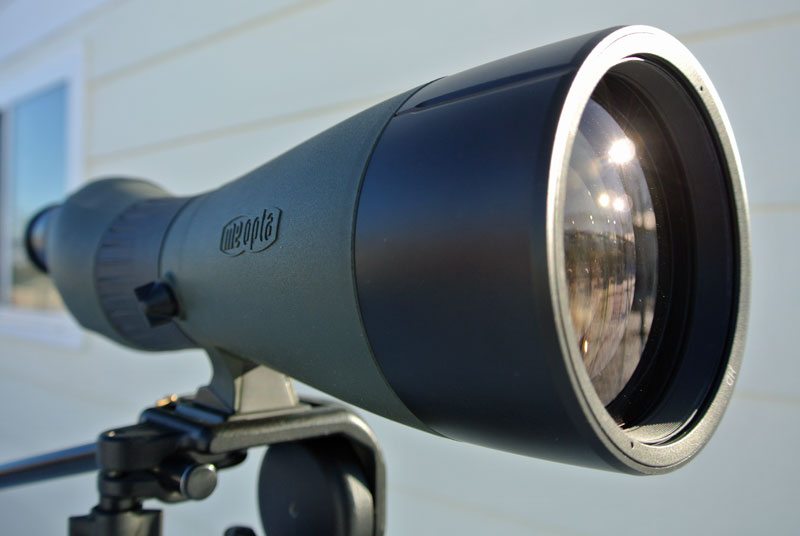
Size – Weight:
The straight eyepiece S2 spotter is a full size spotter. It is 16.5 inches long and 4 lbs. 1.9 ounces on my scale with the 30-60 WA eyepiece attached. My Zeiss Diascope 85tFL for comparison, is 4 lbs. 5.3 ounces with the big 20-75 super zoom attached.
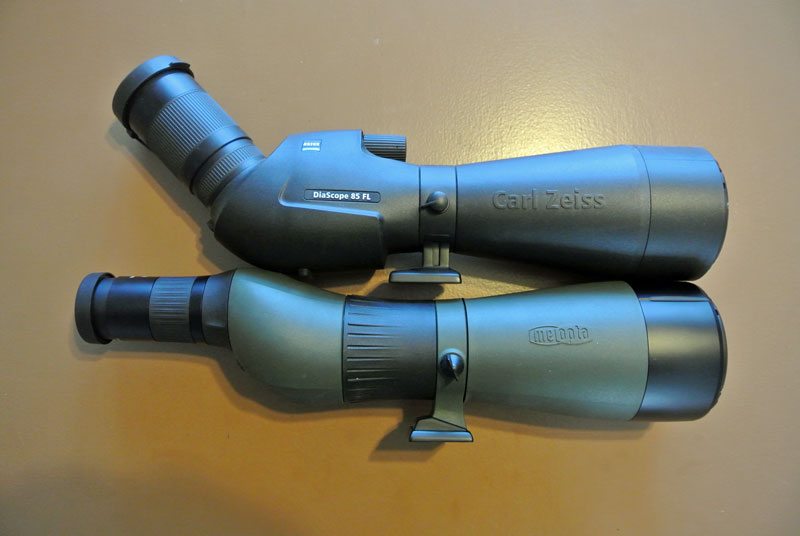
Zeiss 85t FL Diascope (top) compared to Meopta S2 HD 82 (bottom)
Build quality and features:
The S2 is a slender scope with tough, lightly textured green rubber armor throughout and a large, ribbed helical focuser around the main body that is similar to the ATM/STM spotters from Swarovski. The Eyepiece attaches via a locking bayonet mount with a push-button release. The zoom ring is on the eyepiece and is rubber covered. Everything about fit and finish on this scope is as good as anything available. The zoom ring and focuser are buttery smooth, and everything fits tight and square. Both are well-damped and precise. The eyepiece has a twist out eyecup that is similar to that of high end binoculars, with a comfortable, angled rubber ring on the exterior. Focusing speed is fast.
After using the Zeiss Diascope extensively, I had grown quite accustomed to the slow fine focus, and so it took some time to get used to the fast helical focus of the Meopta. Originally, I thought this could be an issue, but as is often the case, the fast helical focusing became second nature, and I was eventually able to achieve maximum focus more quickly with the Meopta than the Zeiss. One standout feature for the Meopta is that the scope’s foot is sized and shaped so that it easily clicks into my Manfrotto 128 RC head without an adapter plate. A very handy feature indeed. The goodies list continues with all the trimmings: hydrophobic coatings, hard armor coatings, ED objective, magnesium chassis, and integrated sunshade.
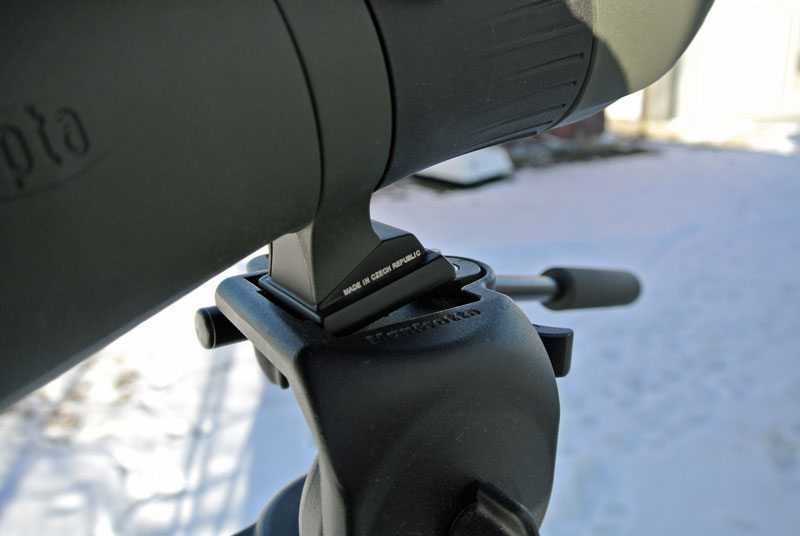
No adapter plate needed thanks to this slick feature
Optical performance:
As one might expect from a $2000 spotting scope, this scope performs at a very high level. After looking at many, many different objects at many different ranges, it became apparent that I could see a touch more detail with the Meopta at 60x than the Zeiss at 60x. However, I was able to discern slightly more detail with the Zeiss at 75x over the Meopta at 60x. When at 60x, the Meopta had a noticeably wider field of view than the Zeiss at 60x. This eyepiece is interesting, as it offers more magnification than the wide angle zooms from Swarovski and Leica (25-50), but also a noticeably wider field of view at all powers than the traditional 20-60 eyepieces from Swarovski and Zeiss. This is a nice balance for hunters although I do miss the ability of the Zeiss to bump up to 75x. Meopta does offer its own super zoom for the S2, which is a 20-70 eyepiece. I would love to take a look at the scope with that eyepiece. Eye relief on the Meopta was more generous than the Zeiss. Sometimes while glassing with the Zeiss my eyelashes will contact the ocular lens, but I never had this issue with the Meopta. The Meopta should serve eyeglass wearers well. Overall, I preferred the Meopta image in general.
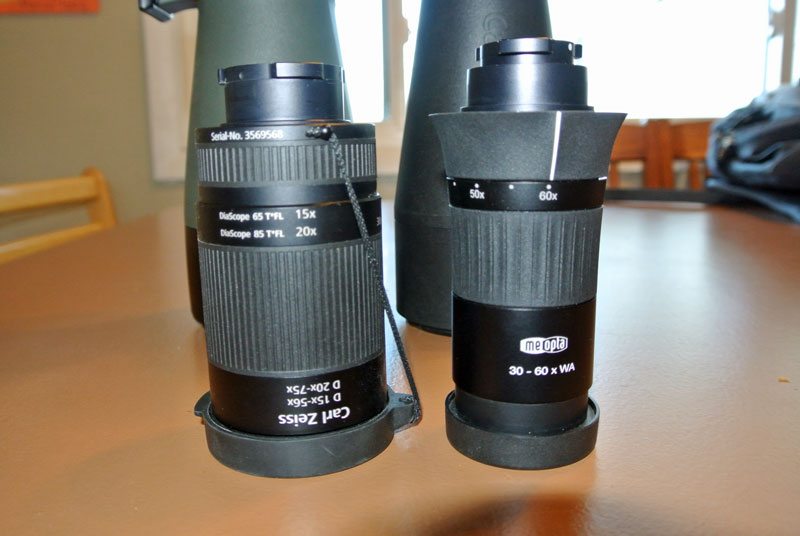
The eyes have it! Zeiss Diascope 20-75 eyepiece (left), Meopta 30-60WA (right)
The S2’s aberration control is excellent, with the center of the field being completely free of chromatic aberration (CA) while the edge shows only a hint in high-contrast areas. In this area, the Zeiss is similarly CA free in the center, but shows slightly more at the edge. Other aberrations are very well corrected, leaving a wide, sharp image right to the edge. Depth of field was also excellent, and a little deeper than the Zeiss. This gave the Meopta an advantage in achieving focus quickly, and also seemed to help resist mirage when compared to the Zeiss.
Distortion was quite unusual in that the Meopta shows minor barrel distortion at lower powers. As you go up in the zoom, the field becomes flat and finally just slightly pincushion at the max power. Most spotters, including the Zeiss, show some pincushion distortion to avoid rolling ball while panning. The Meopta lost the barrel distortion as you turned the magnification up, and the field was nearly flat, with just a tiny bit of pincushion distortion at 60x. Not surprisingly, I did notice some rolling ball when panning the Meopta on lower powers. When not panning, distortion was unnoticeable, and a sharp image extended right to the edge, which was impressive with the wide fields of view.
Low light performance was similar between both scopes, but the Zeiss had the slightest edge on apparent brightness in the lowest light. Contrast is where the Meopta really separated from the Zeiss. The Meopta clearly was engineered with contrast in mind. Colors were saturated, and subtle differences in color were easy to see. Stray light control was good, but I did get some glare artifacts when glassing some bedded elk at a hard angle to the sun. Since then, I have been unable to duplicate that artifact. The Zeiss handles glare quite well.
Meopix adapter:
The Meopix adapter was really fun. It seats quite firmly and solidly on the eyepiece, and the iPhone 4 camera lines up with the exit pupil perfectly. I have an iPhone 5, so I had to borrow my wife’s phone to test the adapter. It took a bit of playing around, but once I downloaded a camera app with a timer, results got quite a bit better. It is downright amazing the quality of pics and video you can get out of the phone with the Meopix adapter. Another neat feature was it turned the phone into an electronic display of the spotter image for multiple people to view easily. The relative low cost and ease of use make the adapter a must have for those that have an iPhone 4 or 4s. I hope they expand their offerings to the iPhone 5, and other phones. I could see this accessory being an especially great benefit to the backcountry hunter that wants to consolidate their phone, GPS, camera, and digiscoping setup into one ultra light package.
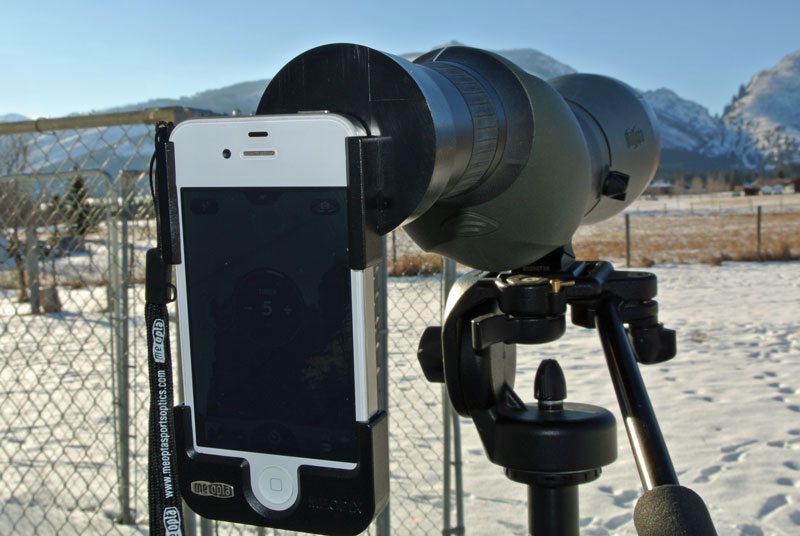
Meopix iPhone 4/4S adapter ready for use

Sample “iScoped” photo – This mule deer doe was nearly 2 ½ miles away
Conclusion:
Meopta has provided another optic that fully competes with the class-leaders, only at a lower price point. The more expensive Zeiss maintains a very slight advantage over the Meopta in low light performance and features a higher maximum magnification. However, the Meopta takes the lead in field of view, depth of field, and contrast, while giving up nothing in apparent resolution (at similar magnification). In fact, I preferred the Meopta image at 60x to that of the Zeiss at 60x. When considering the lower cost, I think the Meopta S2 spotter should be given close consideration by hunters looking for a top-level spotter. I would prefer the Meopta with the 30-60 WA over any spotter I have yet seen with a traditional 20-60 zoom. The Meopta S2 HD is also the only spotter in its price range with a high magnification eyepiece available.














